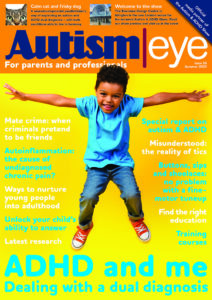Researchers at the University of Brighton are using state-of-the-art eye-tracking equipment in order to understand more about autism and other conditions.
The university is using a £50,000 kit comprising eye-tracking glasses and a psychophysiology measuring system. It allows a person’s gaze to be tracked on still images, videos or websites.
![]() The eye-tracking glasses, which are connected to a smartphone in the user’s pocket, record exactly where the user is looking. Audio is recorded at the same time.
The eye-tracking glasses, which are connected to a smartphone in the user’s pocket, record exactly where the user is looking. Audio is recorded at the same time.
Researchers at the university’s School of Applied Social Science said the eye-tracking technology could help us to understand more about a wide range of conditions, including autism, diabetes, Alzheimer’s disease and mental health issues.
It could also help to identify the causes of poor reading skills and thereby enable the development of learning programmes for dyslexic children. It could even help to explain human interactions such as shopping behaviour and how people perceive art.
Dr Gemma Graham, University of Brighton lecturer in forensic psychology, said: “Eye-tracking technology is a growing field used to detect eye movements and analyse human processing of visual information in both the lab and in natural environments.
Eye-tracking: innovative and informative
“The data is innovative and informative, allowing researchers a unique insight into how we attend to and understand the world around us. Eye tracking is used to train athletes and lifeguards, and it can even help in criminal court cases, for example, explaining how people view CCTV footage, particularly when instructed to focus on specific features in the footage and witnessing different severity of crimes.
“This research is important as CCTV footage is used as evidence in court. However, very little is known about the behavioural characteristics of the CCTV observer and the strategies applied by observers when visually attending to CCTV footage.”
Joe Rennie-Taylor, a psychology technician, said: “The new psychophysiology monitoring equipment is capable of measuring autonomic nervous system functions, including blood pressure, heart rhythm and electrical activity produced by skeletal muscles.”
He added: “These inputs could be combined in many ways, for example to replicate the polygraph or lie detector. This system is modular and can be expanded to measure many more inputs as needed in future, depending on the research interests of people using it. It allows measurement of emotion, arousal, stress and startle and could be worn wirelessly by the same person wearing the eye-tracking glasses or sitting at the mobile eye tracker, to explore conscious and unconscious processes at the same time.”
The University of Brighton purchased its eye-tracking glasses and psychophysiology measuring kit with funds from the Higher Education Funding Council for England’s Research Capital Investment Fund.
Published: 5 October 2016















